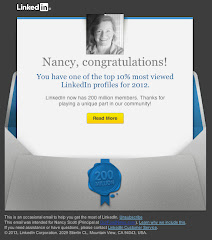Tuesday, April 30, 2013
Big Data Doesn’t Know A Thing, But It Sure Can Ask the Right Questions
When I was 12, I remember telling my mother that if a human being could know all the events that factor into the moment just before an automobile accident, it would be possible to avoid the accident. Little did I know that, a) I was talking about “big data;” b) I was wrong.
Fortunately, a couple of guys who actually know what they’re talking about have written the book that explains it all: Predicting the Future With ‘Big Data’.
Kenneth Cukier is data editor for The Economist and Viktor Mayer-Schönberger is Professor of internet governance and regulation at Oxford University. The co-authors appeared on the Kojo Nnamdi show March 7.
If I understand what Cukier and Mayer-Schönberger are saying, big data leads us not to more facts, but to more data, within which will be more questions and, therefore, greater opportunities for insights. And yet, the whys of “the universe” will remain a mystery.
More Data Is Just More Data
The paradox, apparently, is this: More data negates — or at least counter-balances — the need for perfect data. Mayer-Schönberger puts it this way: “… as we have more data, we can also be accepting some inexactitude in how we collect the data and how perfectly curated the data is because we just have so much of it … [And, any move away from] an elusive quest to find causality, targets something much more pragmatic and much simpler called correlations. It means that we are not looking for the why. We are looking for the what and that’s good enough.”
The Power of the Spread Is the Greatest Power Yet
Mayer-Schönberger thinks both the invention of the printing press and the invention of the Internet will be dwarfed by another major leap forward: not the mere spreading of information, but the spreading of the power of information. [Crowd-sourcing, anyone? Or, maybe, targeted sharing?]
Say what? Cukier explains. “You can imagine that [big data is] going to actually change the way that businesses run. They’ll find their most precious asset might not be what they’re actually building [or selling or offering], but the data that goes into it — because they can learn from [that data] and cross-apply it to other things.”
Got data?
You’re in the cat bird’s seat. And you know it. As a marketer, you know better than to despair at data results. You just test again … and again. You just get more data.
Cukier gives us a good example: “Imagine an algebra teacher who would find out that 60 percent of her students got the same question wrong with the exact same answer. She would, therefore, learn that, in fact, maybe she taught the algebra wrong, that maybe she wasn’t clear enough.” Insight. New testing. More data.
Data Is Fake
Should we worry about the issue of big data and our privacy? Sure, because we always need to be vigilant as a society not to misuse or abuse big data. But keep calm.
Cuckier explains. “Data is only a simulacrum of reality. It is not the real thing, firstly. Also, we’ll never have all the data. That’s not actually possible … So this sort of hypothetical thought experiment of what will happen when we know everything about everyone, that day is just not going to happen. So on a practical level, to get wound up in knots about this doesn’t seem useful..”
If only I’d known then what I know now …
scrubbed by MarketingBrillo
Wednesday, April 10, 2013
Copywriting, sure. Graphic design... Oh My Wowser!
An article in Print magazine's enewsletter [April 10, 2013] reminded me how much we owe graphic designers [artists!] and how little homage we pay them.
Just look at these two graphics.
The first was created for Emerge magazine in 1994 to illustrate an article entitled "The First Amendment: Friend and Sometimes Foe."
The second graced the cover of an LGBT Marriage and Family Resources brochure in 2004.
I keep staring.
Print's article is promoting Dejan Krsic's book Mirko Ilić: Fist to Face. Krisic says, "You'll love this book if you:
1) love Time Magazine's art direction;
2) want to read an amazing story of perseverance and greatness;
3) have respect for the history of one of the greatest designers of the past generation.
I'd add one more reason. You'll love this book if these graphics:
4) make your mouth water, make you want to cry, or just make you want to stare.
Krsic describes llić as "a visionary and a leading voice of visual culture across disciplines and continents." That sentence made me think (again) of the brilliance and power graphic designers have brought to the marketing/advertising/social media/pop culture world that surrounds us.
On Mad Men, it's all about the copywriters and the wordsmiths. The artists are long-haired, bearded, pot smokin' freaks (Season 6). Not fair. The best ones -- like Ilić -- are serious souls who have helped change our world.
So, hug your graphic designer today. It's time.
Wowser!
Subscribe to:
Posts (Atom)


